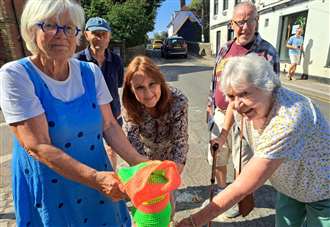A traffic bollard has been given a colourful cosy by members of a village knitting group in the hope it might improve safety.
The sleeve in bright neon colours is not just a bit of fun, the ladies of the Yalding Knit and Natter group hope it will help prevent accidents.

Yalding has at its centre a medieval Grade I-listed bridge which is so narrow, it can only take traffic in one direction at a time.
Traffic journeying westwards towards Tonbridge often has to stop in the High Street outside the village library to let traffic coming over the bridge through.
But the road is still narrow even at this point, and if a lorry or bus is approaching, vehicles often run up onto the kerb to create more room.
Villager Elke Day said: “That’s a danger to pedestrians, especially to the children who use the library and step out onto the pavement at this point.”
KCC has attempted to discourage the practice by erecting bollards on the kerb, but they keep getting taken out by motorists.

Mrs Day said: “It’s been a problem for years.
“There is a 7.5-ton weight limit on the bridge, but nobody observes it. The trucks still go through.
“KCC first put an ordinary bollard there. It lasted a day.
“Then they put a heavy bell bollard in place.
“That lasted quite a long time, but cars used to ride up on top of it.

“Eventually, it too was dislodged from its foundation, and KCC took it away.
“Then a week ago, they put in two new black plastic bollards.
“One was gone within two days.
“It seems that motorists just don’t see the bollards.
“So we decided to knit a colourful cosy for the one remaining bollard, in the hope that it will make it more visible.”

The eight-member Knit and Natter group meets weekly at the library, as do many other groups such as the Lego Club and The Reading Club.
Villager Jill Strappini said the route had long been a problem. She said: “My family don’t like coming to visit me because they find it so difficult getting over the bridge.”
Elke’s husband, Stephen Day, said that people often ask why there aren’t traffic lights to control movement over the bridge.
He said: “But that would result in vehicles waiting with their engines running in the High Street and in Benover Road/Lees Road, for 24 hours a day, instead of about 30 minutes a day at present.
“Since waiting traffic would have to stand at a point wide enough for large vehicles to pass without mounting the pavement, the lights would have to span a distance of some 200 yards, from the Post Office to The Forge.
“Waiting for this span to clear after each change of lights would entail a delay of about a minute, during which time the bridge would be carrying no traffic, reducing traffic throughput.
“The capacity would also be reduced by instances of a green light showing to an empty road.”
Mr Day also suggested that traffic lights could make the situation even more dangerous, with traffic speeding up to make the lights.
He said: “At least, at present, drivers proceed with some caution as they approach the bridge, knowing they may encounter oncoming traffic.”
He added: “We know from past experience when there have been temporary lights for roadworks that the tail-backs have been spectacular.”
KCC was asked for a comment.
